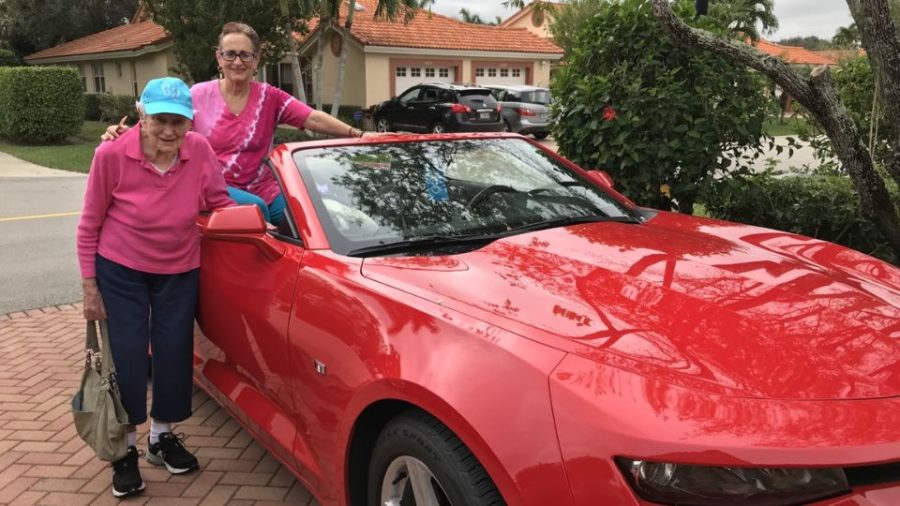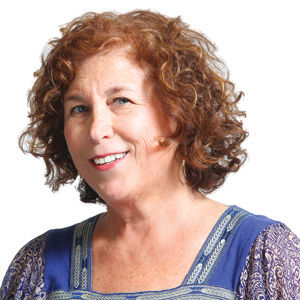Reeling from the loss of her mom, this rabbi created an online community for healing
Rabbi Geela Rayzel Raphael (at right) created the Nechama Minyan on Zoom to say Kaddish for her late 94-year-old mother, Natalie Robinson (pictured above at left). Over the past two years, the minyan has continued nightly (except Shabbat and holidays) and has provided a communal space for roughly 1,000 people. The minyan is named after Raphael’s mother’s Hebrew name, which means “comfort.”
Published October 19, 2022
On Dec. 31, 2020, New Year’s Eve, Rabbi Geela Rayzel Raphael’s mother passed away from complications of COVID. In the height of the pandemic, a “Zoom shiva” was the only practical option to mourn her loss with family — and feel supported by friends. So Raphael reached out to an extensive network of rabbinical and cantorial colleagues in the hopes they could lead a service for the traditional seven-day shiva period. She explained that the week of prayer was so “supportive and uplifting” that she asked others to lead services for an additional 30 days (for a secondary mourning period called sheloshim) while she said Kaddish.
“I had this idea that if we were going to do this for 30 days, I’d have 30 different spiritual leaders — rabbis and cantors — each leading the service so that it would be something different every night,” said Raphael, a Reconstructionist rabbi who lives in Philadelphia and is known as Reb Rayzel or Rabbi Rayzel. “It was just so wonderful to be together, even if we couldn’t be together in person. More and more people started to join me during the 30 days whose family member had passed away and they needed a place to say Kaddish. So I kept it going another month.”
Another month grew into another month, then six months, then a year. Over time, more people started to join because either they or a family member had COVID or were seriously ill and wanted healing prayers for emotional and spiritual support and comfort.
Today, the Nechama Minyan, named after Raphael’s mother Natalie Robinson (whose Hebrew name was Nechama — meaning “comfort” in Hebrew), is nearing its two-year anniversary, and still going strong.
The roughly hour-long service occurs every night, except on Shabbat and Jewish holidays, at 8 p.m. CST, and usually attracts anywhere from 10 (the minimum for a minyan) to upwards of 25 people from locales across the United States and Israel. The minyan’s main source of publicity has been word-of-mouth. Some participants attend regularly while others do so every so often (often for a loved one’s yarzheit) and still others drop in and out.
And while the service changes nightly depending on who is leading, healing prayers and Kaddish are always the focus.
“At this point, the Nechama Minyan not only is something meaningful to me personally, but also is serving a wider cause,” said Raphael, adding that roughly 1,000 people have participated in the minyan, at least once, since it began on Jan. 1, 2021.
“It is serving to connect people across denominational lines; people who need a place to pray, to grieve, to heal, to experiment with different forms and modalities of prayer,” she said. “It also serves as a ‘homeroom’ for those participants coming at the end of the day to check in on their lives and pray for healing and process feelings that arise during the day.”
Building a network of prayer leaders
Raphael is actively involved in the Jewish Renewal movement, which seeks to reinvigorate Judaism with mystical, Hasidic, musical and meditative practices drawn from a variety of traditional and non-traditional Jewish sources and others. Several minyan regulars, including some rabbis and cantors, are also connected to the movement and have helped Raphael by both showing up to ensure the count for a minyan and/or taking turns directing the service. As time has gone on, some of these clergy have mentored rabbinical students, Kohenot (female spiritual leaders) and lay leaders interested in leading the service so that now, says Raphael, the minyan has more than 150 volunteer leaders.
“The Nechama Minyan is a forum for rabbinical and cantorial students to try out and hone their skills,” said Raphael. “It has become a lab for lay leaders to test their skills. I’m there most of the time, but when I can’t be, there are other people who have
been trained to host and can help. What each prayer leader brings to the service also sets the tone of the meeting so that each one feels somewhat different than the last.”
Over the course of several months, I attended a handful of the minyans; each was a little different, though all were welcoming. In addition to the evening liturgy, some leaders incorporate singing, davening and/or storytelling into the service while others lead the group through meditative exercises designed to help everyone wind down and relax.
One by one, participants on the Zoom offer names of friends and relatives they want to heal, like 10-month-old identical twins Ace and Banks who were born prematurely. Both twins had COVID and seemed to recover, though Banks had to be hospitalized for seizures that still weren’t under control.
Others remember their beloved deceased by reciting Kaddish, and sometimes share a short story to highlight a memory. And still others, like me, mostly listen with their video turned off.
Even after the service is officially over, several stay on to catch up and visit. The empathy in this virtual community is palpable; clearly over time, regular participants have become close friends.
“Nechama Minyan is a place where we witness and do not try to solve every feeling and problem that arises, although in our ‘oneg’ afterwards, we often try to help each other with advice and support,” said Raphael. “Nechama Minyan is a sign of the new paradigm whereby virtual communities can feel intimate and connected and durative and supportive.”
She and others note however, that in no way does Nechama Minyan try to take the place of synagogues.
“We support our members to stay connected to their own synagogue/temple, which is why we do not meet on Shabbat and holidays,” added Raphael. “We also help people find communities to go to for Shabbat and holidays.”
Why they come, and why they stay
Rabbi Jay Weinstein, who goes by Rabbi Jay, joined the Nechama Minyan in January of this year after hearing about it through ALEPH: Alliance for Jewish Renewal, where he was ordained in 2008. He leads the minyan most Tuesdays but typically joins six nights a week and serves as one of five “Zoom gabbais,” who help with hosting if needed and ensure that everything runs smoothly. He says he remains involved for a variety of reasons.
“I feel I’m giving back to the ALEPH rabbinical school where I went, and I feel like I am giving back to the community,” said Weinstein, spiritual leader of Congregation Simchat HaLev in Woodbury, N.Y., whose tagline is “Judaism fueled by love.”
“I am a spiritual counselor in addition to a rabbi and have lots of experience with end-of-life issues, death and bereavement. I want to hold space for those who are in grief,” he added. “I also have met a lot of nice people, and I like Reb Rayzel and helping her.”
Chaya Lerner, who was ordained through ALEPH as a rabbinical pastor (she also is a social worker and does pastoral counseling), first checked out the minyan in April of 2021 but started coming regularly that June, after a 12-story condominium building near Miami, Fla. collapsed, killing 98 people. Lerner, who lives in Miami, didn’t personally know anyone who was killed but through her work as a case manager with Jewish Community Services of South Florida, she provided counseling and grief support to those whose family members had not yet been found in the ruble.
“I really didn’t have any place to say Kaddish,” said Lerner. “I had left my synagogue, and the community I daven in typically only meets on Saturday morning. I didn’t really talk about (the tragedy) — saying 98 people got crushed to death tends to put a damper on everything. But I really needed a place to bring my grief.”
She found that place at Nechama Minyan, which she describes as a “warm and loving community” that has given her a safe place to grieve.
“This strength helped me give my clients help in their bereavement,” said Lerner, who now leads the minyan once or twice a month and attends regularly. “I see myself staying with (the minyan) for a long time. It’s something I really enjoy. I’ve grown to care about the people who are ‘regulars’ and the kind, supportive, caring community we have created.”
Those sentiments were echoed again and again. Barbara M. of upstate New York, who joined in March, found solace in being able to “relax and float” with the service after spending the day taking care of her ailing mother. Once her mother passed earlier this fall, she wanted a place to say Kaddish daily, but her synagogue doesn’t hold services every day.
“It was easy to become part of this informal, loose-knit group of people who care about one another and more or less worship in a similar matter or are at least willing to try new approaches to old traditions,” she said. “As I go through the 11-month mourning period following my mother’s passing, I have others with whom I can share on a regular basis, if I wish to, my sorrow and my happy memories of mom. I also have the honor of being able to bear witness for other people and learn about the people they love who have passed on.”
Raphael readily admits she had no idea that when she began sitting shiva for her mother that it would turn into an ongoing minyan, with no end in sight, that positively impacts so many people.
“Nechama Minyan was created out of one person’s need, but it is offered comfort and support to many,” she said. “Out of the ashes of my mother’s death, I now have so many new friends to help fill the hole in my heart that she left.”
If you are interested in joining the Nechama Minyan, email Raphael at [email protected].
















